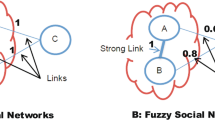Abstract
The rapidly growing global interconnectivity, brought about to a large extent by the Internet, has dramatically increased the importance and diversity of social networks. Modern social networks cut across a spectrum from benign recreational focused websites such as Facebook to occupationally oriented websites such as LinkedIn to criminally focused groups such as drug cartels to devastation and terror focused groups such as Al-Qaeda. Many organizations are interested in analyzing and extracting information related to these social networks. Among these are governmental police and security agencies as well marketing and sales organizations. To aid these organizations there is a need for technologies to model social networks and intelligently extract information from these models. While established technologies exist for the modeling of relational networks [1–7] few technologies exist to extract information from these, compatible with human perception and understanding. Data bases is an example of a technology in which we have tools for representing our information as well as tools for querying and extracting the information contained. Our goal is in some sense analogous. We want to use the relational network model to represent information, in this case about relationships and interconnections, and then be able to query the social network using intelligent human-centered concepts. To extend our capabilities to interact with social relational networks we need to associate with these network human concepts and ideas. Since human beings predominantly use linguistic terms in which to reason and understand we need to build bridges between human conceptualization and the formal mathematical representation of the social network. Consider for example a concept such as “leader”. An analyst may be able to express, in linguistic terms, using a network relevant vocabulary, properties of a leader. Our task is to translate this linguistic description into a mathematical formalism that allows us to determine how true it is that a particular node is a leader. In this work we look at the use of fuzzy set methodologies [8–10] to provide a bridge between the human analyst and the formal model of the network.
Access this chapter
Tax calculation will be finalised at checkout
Purchases are for personal use only
Similar content being viewed by others
References
Carrington, P. J., Scott, J. and Wasserman, S., Models and Methods in Social Network Analysis, Cambridge University Press: New York, 2007.
Wasserman, S. and Faust, K., Social Network Analysis: Methods and Applications, Cambridge University Press: New York, 1994.
Scott, J., Social Network Analysis, SAGE: Los Angeles, 2000.
Chartrand, G., Introductory Graph Theory, Dover Publications: Mineola, NY, 1977.
Bollobas, B., Modern Graph Theory, Springer: New York, 2000.
Berge, C., The Theory of Graphs, Dover Publications: Mineola, NY, 2001.
Newman, M., Barabási, A. L. and Watts, D. J., The Structure and Dynamics of Networks, Princeton University Press: Princeton, NJ, 2006.
Zadeh, L. A., “Fuzzy sets,” Information and Control 8, 338–353, 1965.
Yager, R. R. and Filev, D. P., Essentials of Fuzzy Modeling and Control, Wiley: New York, 1994.
Nguyen, H. T. and Walker, E. A., A First Course in Fuzzy Logic, Chapman and Hall: Boca Raton, FL, 2005.
Zadeh, L. A., “Fuzzy logic = computing with words,” IEEE Transactions on Fuzzy Systems 4, 103–111, 1996.
Zadeh, L. A., “Generalized theory of uncertainty (GTU) – principal concepts and ideas,” Computational Statistics and Data Analysis 51, 15–46, 2006.
Bargiela, A. and Pedrycz, W., Granular Computing: An Introduction, Kluwer Academic: Amsterdam, 2003.
Zadeh, L. A., “A computational approach to fuzzy quantifiers in natural languages,” Computing and Mathematics with Applications 9, 149–184, 1983.
Yager, R. R., “On ordered weighted averaging aggregation operators in multi-criteria decision making,” IEEE Transactions on Systems, Man and Cybernetics 18, 183–190, 1988.
Pedrycz, W. and Gomide, F., Fuzzy Systems Engineering: Toward Human-Centric Computing, Wiley: New York, 2007.
Yager, R. R., “Quantifier guided aggregation using OWA operators,” International Journal of Intelligent Systems 11, 49–73, 1996.
Yager, R. R., “Applications and extensions of OWA aggregations,” International Journal of Man-Machine Studies 37, 103–132, 1992.
Author information
Authors and Affiliations
Corresponding author
Editor information
Editors and Affiliations
Rights and permissions
Copyright information
© 2010 Springer Science+Business Media, LLC
About this chapter
Cite this chapter
Yager, R.R. (2010). Associating Human-Centered Concepts with Social Networks Using Fuzzy Sets. In: Furht, B. (eds) Handbook of Social Network Technologies and Applications. Springer, New York, NY. https://doi.org/10.1007/978-1-4419-7142-5_21
Download citation
DOI: https://doi.org/10.1007/978-1-4419-7142-5_21
Published:
Publisher Name: Springer, New York, NY
Print ISBN: 978-1-4419-7141-8
Online ISBN: 978-1-4419-7142-5
eBook Packages: Computer ScienceComputer Science (R0)




